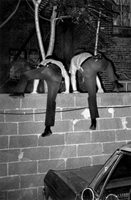When photographer Jill Freedman embedded with the New York City Police Department’s Ninth and Midtown South Precincts in 1978, the city was just past its postwar nadir. Three years earlier, in the eyes of Daily News editors, President Gerald Ford had told the struggling metropolis to “drop dead.” The summer of 1977 had been marked by the tragic denouement of the Son of Sam killing spree, as well as rioting and looting under cover of the July blackout. In a city troubled by crimes both petty and spectacular, Freedman sought to counter the largely negative opinion of cops on the beat, to humanize the men and women behind the badge.
The officers with whom she cruised for three years were certainly busy: The Ninth Precinct covers the East Village, where junkies lay strung out in buildings burned for the insurance money and then abandoned, while Midtown South incorporated the hustling and vice of Times Square. There is a man Stabbed Twice in the Guts, 1980, and one Caught in the Act, 1978, while trying to boost a turntable, and one who tried to score a Free Lunch, 1979, by skipping out on his restaurant bill. Through it all, Freedman’s blue-shirts handle their duties with a sense of humor. They know that George Likes to Sit in Garbage Cans, 1981, and that this little boy in the cruiser is Always Running Away, 1979. Several of Freedman’s images match this humor with visual wit, as with the Partners, 1978, who are hopping a cinder-block wall with symmetrically outstretched legs, or the Street Cops, 1978, belly to belly in a cramped hallway, one holding his pistol while the other clasps a stogie.
Viewed today, after more than two decades of zero-tolerance “broken windows” policing and in the midst of overreaction to #OccupyWallStreet protesters, the humanity and self-awareness Freedman identifies in her subjects is all the more remarkable. She deftly captured a moment unlike our own in several ways. While I wouldn’t trade the safety of today’s city for its late-1970s incarnation, I do wish today’s officers, many of whom are high-strung and alienated from the communities they patrol, would learn from their predecessors’ relative good will.

